Noltea africana
Noltea africana (L.) Endl.
Family: Rhamnaceae
Common names: soap glossy-leaf, noltea, soap bush, soap dogwood (Eng.); seepblinkblaar, seepbos (Afr.); umkhuthuhla, amaluleka, iphalode, umglindi (isiXhosa), umahlahlakwa, umaluleka (isiZulu)
SA Tree No: 453
Introduction
An ornamental shrub or small tree with clusters of fragrant white flowers from winter to spring.
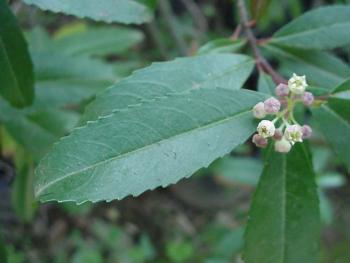
Description
Description
Noltea africana is a shrub or small bushy tree, that grows 2–6 m tall, depending on the climate and condition of the area. The stem is slender with brown bark. Branchlets are purplish red and the leaf stalks are reddish. The leaves are simple, leathery, alternate, elliptic to oblong with a narrowly rounded apex and a finely toothed margin, and are glossy dark green above and paler beneath.
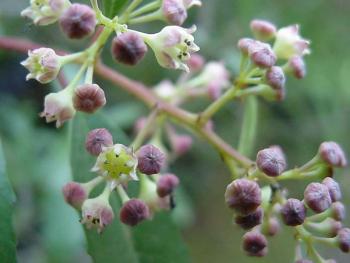
The flowers are very small, 3 mm in diameter, fragrant, and are borne in loose clusters in the axils of the leaves in winter to spring (July–September). The flower buds are purple and open white. The fruits are very small brown woody capsules, 10 mm in diameter, that open to release black seeds in early summer.
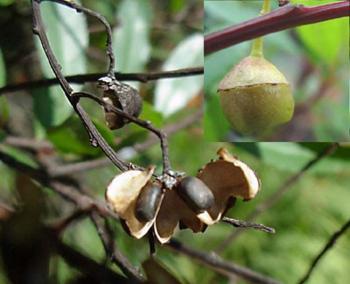
Conservation Status
Status
According to the Red List of South African Plants website, checked on 10/02/2016, the conservation status of this species is Least Concern (LC).
Distribution and habitat
Distribution description
Noltea africana occurs naturally from KwaZulu-Natal, through the Eastern Cape and former Transkei, to the Cape Peninsula in the Western Cape. It is found growing on forest margins, in scrub and on stream banks.
Derivation of name and historical aspects
History
The genus Noltea is named after Ferdinand Nolte (1791–1875), German botanist and professor of botany at the University of Kiel and director of the botanical garden at Kiel. The specific epithet africana, meaning ‘of Africa’, pertains to its African origin. Its common names come from the fact that a soapy lather that is made from the leaves is used as a soap substitute.
Noltea africana is the only species in the monotypic genus Noltea and is endemic to South Africa. N. africana falls under the family Rhamnaceae.
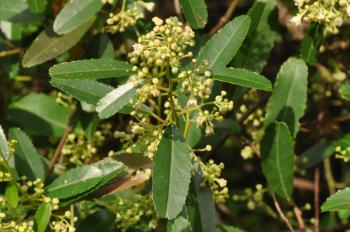
Ecology
Ecology
This is a useful tree for encouraging wildlife into the garden; the flowers attract butterflies, bees and other pollinating insects, and birds take shelter and nest in the bushy crown.
Uses
Use
Traditionally this tree was used for medicinal purposes to treat fever and as an anthelmintic by indigenous healers. In the Eastern Cape, it was used for cattle as prevention and remedy against sponssiekte (quarter evil).
When leaves and twigs are rubbed in water it becomes soapy, and traditionally it was used like soap for washing.
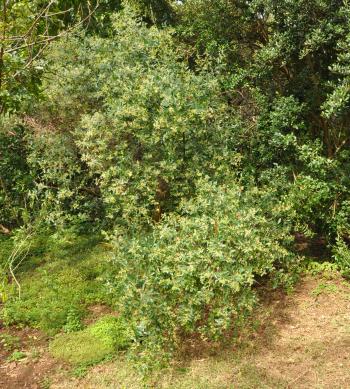
Growing Noltea africana
Grow
Noltea africana is a fast-growing, small tree; it grows well in sunny and semi-shaded areas and makes a good garden plant for formal and informal gardens, and is especially useful for screening and windbreaks. It is suitable for small gardens. On the highveld, it has proven to be frost resistant, bringing much needed green to the brown winters. Plant it in loamy, compost-enriched soil and water moderately.
It is easily propagated from seed.
References
- Coates Palgrave, K. 2002. Trees of southern Africa. Struik, Cape Town.
- Jackson, W.P.U. 1990. Origins and meanings of names of South African plant genera. University of Cape Town.
- Pooley, E. 1993. The complete field guide to trees of Natal, Zululand and Transkei. Natal Flora Publication Trust, Durban.
- Smith, C.A. 1966. Common names of South African plants. Memoirs of the Botanical Survey of South Africa No. 35. Government Printer, Pretoria.
- Grow Wild website: http://growwild.co.za/trees/noltea-africana, accessed 4 March 2016.
Credits
Nenungwi Lufuno
Free State National Botanical Garden
and Alice Notten
Kirstenbosch National Botanical Garden
March 2016
Plant Attributes:
Plant Type: Shrub, Tree
SA Distribution: Eastern Cape, Western Cape
Soil type: Sandy, Loam
Flowering season: Spring, Winter
PH: Acid, Neutral
Flower colour: Purple, White
Aspect: Full Sun, Morning Sun (Semi Shade), Afternoon Sun (Semi Shade)
Gardening skill: Average
Special Features:
Horticultural zones











Rate this article
Article well written and informative
Rate this plant
Is this an interesting plant?
Login to add your Comment
Back to topNot registered yet? Click here to register.